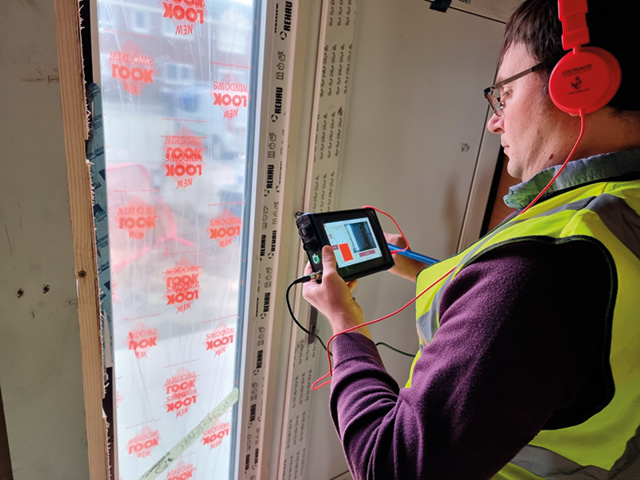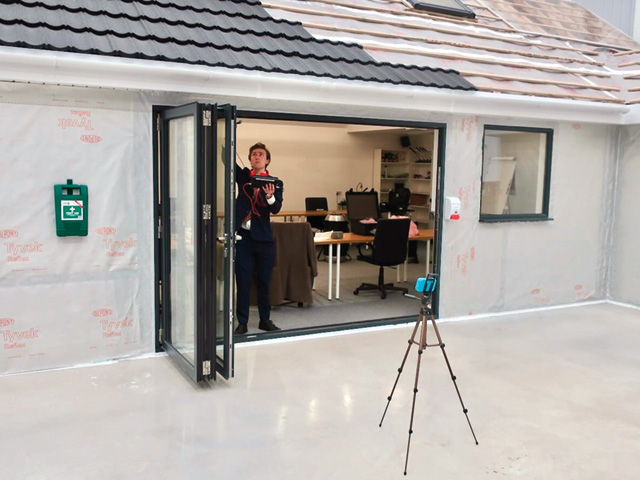
Technology for locating and quantifying air leaks in spaces designed for fire compartmentation is a key tool for reducing the potential spread of flames and smoke throughout a facility, says Dr Carl Stephen Patrick Hunter, chairman of Coltraco Ultrasonics.
Compartmentation is related to fire stopping in walls and floors, to reduce the spread of fire. Room integrity testing can help to ensure that a space is sufficiently sealed to hold in the gaseous extinguishing agent once it has been actuated.
Liquefied gaseous systems are typically made up of carbon dioxide, FM200 or Novec 1230, and non-liquefied systems are typically Inergen or Nitrogen. Leak sites in the room could mean that the compartmented area may not withhold the fire or gaseous extinguishing agent, which has been specifically designed for the space.
The likelihood of the gaseous system effectively extinguishing the fire gets lower as the protected area becomes larger than the size that it was designed for. As well as size, issues in the quality of compartmentation walls can come from maintenance, minor works and refurbishments. Contractors carrying out such tasks can occasionally destroy the compartmentation integrity of the wall, floor or ceilings if they were unaware that the area is a compartmented space.
It is therefore good practice to ensure the fire resistance of walls, floors and ceilings and to safeguard again if necessary.
What are the standards for compartmentation?
Regulations demand that compartmentation is upheld for the safety of the individuals who entrust their lives to its integrity. Approved Document B states that every compartment wall should form a complete barrier to fire between the compartments they separate. It adds that any stairway or other shaft passing directly from one compartment to another should be enclosed in a protected shaft so as to delay or prevent the spread of fire between compartments.
However, despite the regulations’ best effort to promote the implementation of compartmentation and room integrity, the industry is sometimes minimally compliant or even non-compliant due to a lack of understanding of fire systems and their connection to compartmentation.

Gaseous extinguishing / suppression systems are installed to protect special hazards in critical infrastructure as their key objective. However as stated above, if the room has leak sites in its compartmentation and the gaseous extinguishing agent cannot be contained in the room, then the critical infrastructure / building will not be protected from fire.
To understand how fire resistant a compartment is, an inspection of the overall condition of the existing fire compartments is needed, as well as an assessment of the condition and effectiveness of the sealing of wall / soffit interfaces and an inspection of existing fire seals applied to service penetrations through fire compartment lines.
The technology exists right now to solve this problem. Coltraco Ultrasonics has provided a smart solution for quick and easy assurance of compartmentation using ultrasound to detect signal leaking through any apertures within the barriers.
Technology for compartmentation testing
The Portascanner AIRTIGHT 520 is capable of both locating and quantifying air leaks, helping to ensure enclosures are sealed effectively as specified in fire safety standards such as NFPA 2001.
Specifically, NFPA 2001 states that “all total flooding systems shall have the enclosure examined and tested to locate and then effectively seal any significant air leaks that could result in a failure of the enclosure to hold the specified agent concentration level for the specified holding period” and “the protected enclosure shall be inspected annually or monitored by a documented administrative program for changes in barrier integrity or enclosure dimensions”. The Portascanner AIRTIGHT 520 ensures that this standard can be met conveniently and at low cost.
Users of the handheld tool are able to locate air leaks and quantify their significance, thereby ensuring that any further tests such as the Door Fan Test or the PULSE test pass first time, reducing costs. It can be also used in instances where pressurisation tests are impossible or impractical to perform. Once tested, users will possess an electronic record of leak data to facilitate a more systemised approach to enclosure integrity testing.
The advantages of being able to accurately detect the exact leak locations and their size are self-evident when considered alongside the resistance to collapse and transfer of excessive heat. In a case where there is too much leakage in a room, the Portascanner AIRTIGHT 520 supports the rapid and accurate identification of these sites so that they can be sealed.
coltraco.com | sales@coltraco.co.uk | t: 020 7629 8475

